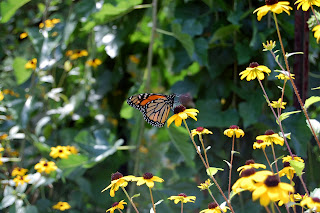The Hummingbird and Butterfly Garden
Four years ago I moved into my ‘dream’ garden.
She said, “It’s a field of soybeans, so go nuts.”
And off I went.
I walked in to the property from the road until it just felt ‘right’ and there I drove a broken hockey stick into the ground. This was the demarcation of my new Canadian garden.
I didn’t realize it at the time, but I had carved off 10 acres of ‘soybeans’ with the intention of converting it into a hummingbird and butterfly haven.
Here is what I have learned about attracting butterflies and hummingbirds:
You can attract butterflies and hummingbirds (and song birds too!) largely by your choice of plant material.
Your choice of plants should include lots of native species, if you want to maximize the value of them as ‘magnets’ to butterflies and hummingbirds.
Look for bright coloured perennials and annuals with ‘trumpet’ shaped flowers for the hummers and flat, bold faced flowers for the butterflies that they easily perch on (specifics to come…)
Plant lots of trees for nesting and protection (for the birds, hummers included).
Place lots of still water around your yard for drinking (bird baths work as well as anything – just empty them weekly to avoid mosquito breeding).
This garden performs best in sun to partial sun (so don’t over plant the trees).
It is beneficial to have a hummingbird feeder set up near your kitchen window so that you can see them for yourself, without always having to take a tour of the garden to find the little rascals. Besides, the hummers may just announce their arrival to your place with a visit to your feeder first. You best be there to greet them!
Where do you go from here?
Some details:
1. Make a plan of your butterfly and hummingbird garden now, and be sure to include many of the plants that are known to attract them.
2. Native plants that work: Echinacea purpurea (purple coneflower), Rudebeckia hirta (black eyed susan), yarrow (great for hot dry places), perennial salvia and liatrus (shooting star).
3. Bright, trumpet shaped flowers: trumpet vine, honeysuckle (both the hardy shrub and the vine), salvia, foxglove, lupines, jasmine (tropical, but you can bring it indoors for the winter), hibiscus (the tropical varieties, the hardy perennial and the ‘rose of sharon’ woody shrub) – they all work nicely, lavatera (annual), rose mallow (annual), hollyhock (biannual), delphinium, all hostas, daylilies, fuchsia (annual) and nicotine (annual – and one of the best!).
The ‘flat flowering’ plants that provide a nectar rich platform from which butterflies will feed and ‘spread their wings’ include Shasta daisy, Queen Anne’s Lace, rudebeckia, asters (perennial and annual) and many others.
For the complete list go to http://www.markcullen.com/

4. Plant a mixture of deciduous and evergreen trees as both provide protection, food sources and other varied benefits.
5. I have several bird baths in my front and back garden that get a lot of use – some are more ornamental than practical: all used by birds and butterflies more for drinking than bathing. Remember to dump still water weekly to prevent the mosquitoes from breeding…
6. Bright sunshine is favoured by most butterflies and hummingbirds in fine weather, but trees provide protection from wind and severe weather.
7. I received an e mail from the executive. Director of Hummingbird Canada to say that hummingbirds actually arrive in many parts of Central Canada in mid April, contrary to popular belief. Keep this in mind next spring and get your feeder out early. Go to http://www.wildbirds.com/dnn/Favorites/Hummingbirds/tabid/694/Default.aspx
Be sure to clean out your feeder every week or so to prevent mold from building up inside of it.
And keep in mind that hummingbirds are migratory. They pass through our gardens in urban and suburban areas once in spring and again in late summer/early fall. I find that it is easier to get them to stick around during their southern migration late in the season.
So – be ready. The most desirable wildlife is about to arrive at the party. And with it, our reputation for being quiet, modest Canadian people that everyone seems to think that we are, is about to fly out the window.
Keep your knees dirty,



